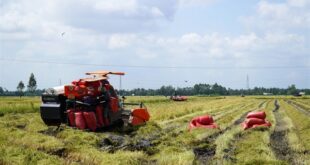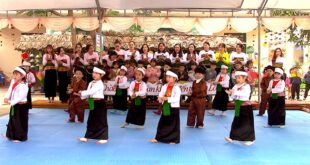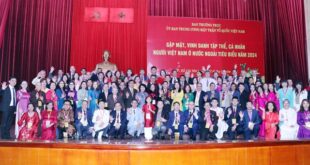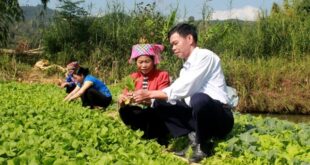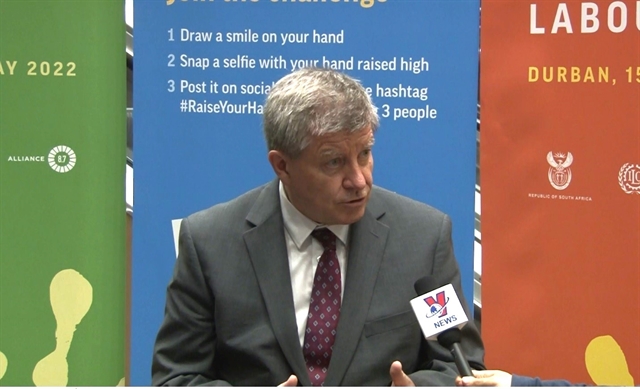
Director-General of the International Labour Organisation (ILO) Guy Ryder has praised Việt Nam’s pioneering role and efforts to eliminate child labour during an interview granted to the Vietnam News Agency (VNA)’s correspondent in South Africa on the sidelines of the 5th global conference on the elimination of child labour in Durban.
Việt Nam is one of the Pathfinder countries of the Alliance 8.7. What does it mean to the fight in Chapter Eight labour and like, what can Việt Nam in particular, and other parts of the countries do to further contribute to the fight?
Alliance 8.7 is a global alliance of governments, civil society organisations and international organisations to fight against child labour, and indeed forced labour. And we’re very pleased that Việt Nam has joined as one of 26 pioneer countries. What does that mean? It means that Việt Nam is putting its hand up and volunteering to make a particular accelerated effort to get rid of child labour. And this is not just something on paper. We’re actually doing major activities with Việt Nam and Việt Nam is making important progress.
I’m very pleased at Việt Nam. You have a national policy to get rid of child labour. We are doing good cooperative work with Việt Nam to try to build capacities and to make sure that your legislation which has been put in place produces results. All of this is concrete. It’s for real, it’s not theory. As your country becomes more integrated into the global economy, into global supply chains, and also concluding important trading agreements, not least with the European Union, where there is a strong interest in labour standards, Việt Nam has clearly decided that it wants to be seen as making a very serious effort in respect of child labour.
So at this point, I’m extremely pleased with that cooperation. And I’m optimistic because it is concrete, that it’s going to produce good results for Việt Nam, and for of course, the global effort against child labour.
Can you brief us on the situation of child labour globally? Why is child labour still happening? And do you see any differences among countries and continents in the form of child labour?
Indeed, there are 160 million children in child labour at the moment. That means 9.6 per cent of all children are in child labour. That’s a big number. But the good news is that at the beginning of the century in the year 2000, that figure was 245 million, and the percentage was 16 per cent. So in two decades, we’ve come down very considerably, this is a big success. The bad news, however, is since 2016, the figures are slowly going back up again, even before COVID-19. And with COVID-19, we have to worry that the figures are going back up once more. So I think that the challenge of this conference is to regain the momentum that we have lost and try to meet the international goal which was set by the United Nations, which was to eliminate child labour by 2025. We’re not on track, and we have to get back on track.
Now you asked me about the different regions. The progress I’ve mentioned at the global level, has a very clear regional dimension. The Asia Pacific region where Việt Nam of course is located, has had major successes. It’s brought down child labour very quickly and very considerably. The same is true, more or less in Latin America, which also had big declines. The major challenge I think now resides in Africa, where actually numbers are going up and going up quite strongly. The percentage of children in work in Sub Saharan Africa is more than 23 per cent. So that global average of 9.6 per cent is less than doubled in Africa. And that’s one of the reasons we’ve come to Durban in South Africa to renew the struggle.
As we are in Durban right now, how would you evaluate the progresses of the elimination on child labour from the previous four conferences? What have been done? What have not? What can we expect from this conference?
As I’ve said, we had our first conference in 1997. And since then, we’ve reduced child labour about one third. And this is an enormous achievement. And I can’t say all of that is because of the conferences. But what the conferences have helped to do is to establish global understanding of what it takes to beat child labour, what the real levers of policy are, and then to increase commitment to use those levers. So what do we need to do? Well, two things are very clear. Education and accessible education is a key weapon against child labour. If parents have the option of sending their children to school and they can afford to, they will do that. So education is vital.
The second is social protection. We know that parents don’t wish their children to work. Very often they have to make their children work because family income is too low to sustain the family. So we need to see social protection as the second weapon. Income support for poor families makes it more possible for them to avoid child labour.
So these are two levers that we’ve used very effectively. I think there’s a third lever as well. And that is making sure that parents have decent work. They have work that gives them a sufficient income, that they’re out of poverty and their children do not have to work. And we’ve seen these things working.
This is not theory. It’s practice.
There is of course, I think, an international solidarity part to all of this. It is absolutely essential that the global community not only set the target of eliminating child labour, but actually helped support through financing efforts to remove child labour.
Mentioning COVID-19, how has the pandemic affected the ILO’s strategy in technical support to countries?
What we need to understand is COVID-19 is a health emergency and of course, it came to Việt Nam very late because at the beginning you were the miracle country that avoided COVID-19. But COVID-19 has brought a dramatic social and economic crisis.
Our estimates are that in terms of jobs lost and income loss, COVID-19 has had four times more negative impact than the financial crisis of 2008-2009. We haven’t seen a crisis like this for decades. So this was dramatic, and unsurprisingly, this has probably had an influence on child labour.
In the first instance, it might be surprising. It probably reduced child labour because as things closed down and enterprises closed down, children also stopped working but as the lockdowns began to be relaxed, and because people are more vulnerable, and there’s more poverty, we think that there are more children at work because of COVID-19.
And one estimate, we have still had to be confirmed is that probably COVID has brought nearly nine million extra child labourers. So this is quite a dramatic thing and makes our job even more difficult.
What is your message to the world leaders on how to speed up the fight against child labour?
I think there’s two or three things. Firstly, let’s not forget that when the United Nations adopted its 2030 Agenda for Sustainable Development, we did that in 2015. We all decided we would get rid of child labour. It wasn’t an obligation. We decided to do it. So we have to be honest, and try to keep our efforts going. Secondly, I really do understand that the global economy is not easy. There are multiple crises breaking out in the world, but it is our responsibility to keep child labour centre stage. Don’t forget about it. Because as many people have said in our conference, the future depends on our children, and we need to give them the best start. — VNS
- Reduce Hair Loss with PURA D’OR Gold Label Shampoo
- Castor Oil Has Made a “Huge” Difference With Hair and Brow Growth
- Excessive hair loss in men: Signs of illness that cannot be subjective
- Dịch Vụ SEO Website ở Los Angeles, CA: đưa trang web doanh nghiệp bạn lên top Google
- Nails Salon Sierra Madre
 VnExpress News The News Gateway of Vietnam
VnExpress News The News Gateway of Vietnam
